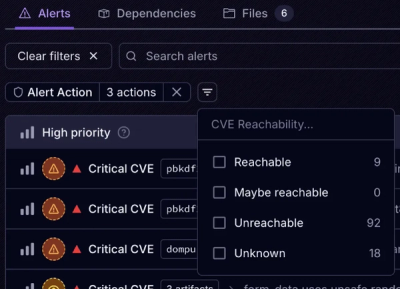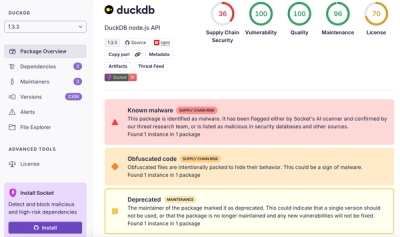
Product
Introducing Tier 1 Reachability: Precision CVE Triage for Enterprise Teams
Socket’s new Tier 1 Reachability filters out up to 80% of irrelevant CVEs, so security teams can focus on the vulnerabilities that matter.
promise-alert
Advanced tools
A wrapper for sweetalert to return promises for use with generators.
$ npm install promise-alert
promise-alert has two exports. promiseAlert calls sweetalert and returns a promise while swal gives you direct access to sweetalert itself.
import { promiseAlert, swal } from 'promise-alert';
// usage without generators
promiseAlert({
title: 'Are you sure?',
text: 'Do you want to continue?',
type: 'warning',
showCancelButton: true
}).then(confirmed => {
// do something
});
The recommended usage is within a generator function. This allows you to write your code and handle the dialog responses synchronously. In this example, I use co to run the generator.
import co from 'co';
import { promiseAlert, swal } from 'promise-alert';
co(function* () {
const confirmed = promiseAlert({
title: 'Are you sure?',
text: 'Do you want to continue?',
type: 'warning',
showCancelButton: true
});
if(!confirmed) return;
// do something
});
For more examples, check out this blog post or continue reading below.
promise-alert takes the fantastic sweetalert library and wraps it so that each call returns a promise. This means that each sweetalert alert, prompt, and confirm you open now returns a promise rather than taking a callback. If you prefer promises over callbacks, then this allows you to use sweetalert in that way. BUT, the real benefits of this comes with generator functions. Using generators, you can write synchronous code calling for alerts, prompts, and confirms as easily as if you are using the browser's native implementations. Let's first look at the old way.
// call an alert using the shorter syntax
swal('Oops!', 'There was a problem.', 'error');
// call a confirm dialog
swal({
title: 'Be careful!',
text: 'Are you sure that you want to continue?',
type: 'warning',
showCancelButton: true
}, confirmed => {
// asynchronously handle the response
});
// call a prompt dialog
swal({
title: 'Name?',
text: 'Please enter your name.',
type: 'input',
showCancelButton: true
}, res => {
// asynchronously handle the response
});
// import promise-alert
import { promiseAlert } from 'promise-alert';
// call an alert using the shorter syntax
promiseAlert('Oops!', 'There was a problem.', 'error').then(() => {
// asynchronously handle the response
});
// call a confirm dialog
promiseAlert({
title: 'Be careful!',
text: 'Are you sure that you want to continue?',
type: 'warning',
showCancelButton: true
}).then(confirmed => {
// asynchronously handle the response
});
// call a prompt dialog
promiseAlert({
title: 'Name?',
text: 'Please enter your name.',
type: 'input',
showCancelButton: true
}).then(res => {
// asynchronously handle the response
});
// import the co library to run the generator
import co from `co`;
// import promise-alert
import { promiseAlert } from 'promise-alert';
co(function* () {
// call a prompt dialog
const name = yield promiseAlert({
title: 'Name?',
text: 'Please enter your name.',
type: 'input',
showCancelButton: true,
closeOnConfirm: false
});
// handle the response
if(!name) {
swal.close();
return;
}
// call a confirm dialog
const confirmed = yield promiseAlert({
title: 'Are you sure?',
text: 'Your name is about to be alerted to the screen. Do you want to continue?',
type: 'warning',
showCancelButton: true,
closeOnConfirm: false
});
// handle the response
if(!confirmed) return;
// call an alert
yield promiseAlert('Yay!', `Your name is ${name}`, 'success');
// all done!
});
Looking at the callback and promise examples, you can see that they are called asynchronously and the only way you could call them one after the other would be to nest them inside each other. Using generators with promiseAlert you can once again write synchronous-looking procedural code which takes in user input without deeply-nested callbacks or promises.
Contributions are welcome! If you have any issues and/or contributions you would like to make, feel free to file an issue and/or issue a pull reuqest.
###License Apache License Version 2.0
Copyright (c) 2016 by Ryan Burgett.
FAQs
A wrapper for sweetalert to return promises for use with generators.
The npm package promise-alert receives a total of 4 weekly downloads. As such, promise-alert popularity was classified as not popular.
We found that promise-alert demonstrated a not healthy version release cadence and project activity because the last version was released a year ago. It has 1 open source maintainer collaborating on the project.
Did you know?

Socket for GitHub automatically highlights issues in each pull request and monitors the health of all your open source dependencies. Discover the contents of your packages and block harmful activity before you install or update your dependencies.

Product
Socket’s new Tier 1 Reachability filters out up to 80% of irrelevant CVEs, so security teams can focus on the vulnerabilities that matter.

Research
/Security News
Ongoing npm supply chain attack spreads to DuckDB: multiple packages compromised with the same wallet-drainer malware.

Security News
The MCP Steering Committee has launched the official MCP Registry in preview, a central hub for discovering and publishing MCP servers.